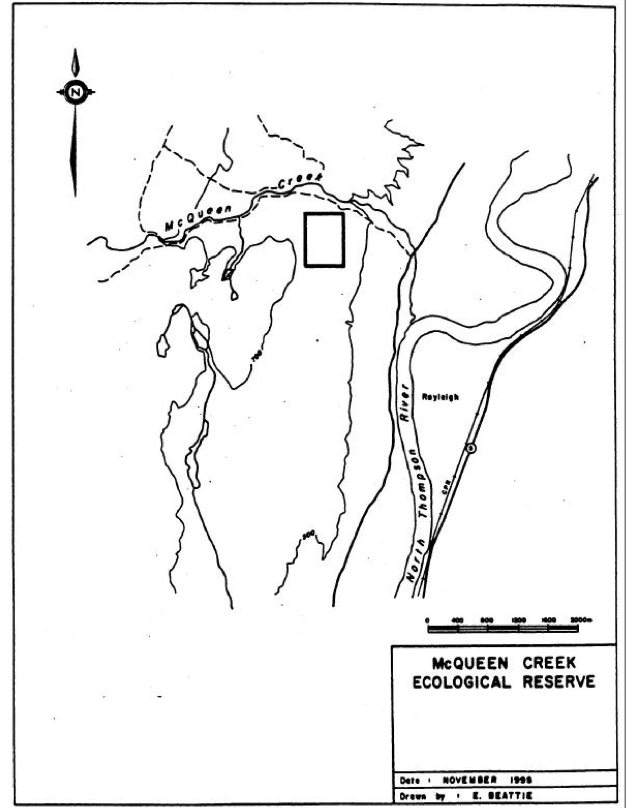
News/Reports
McQueen Creek Management Plan 1996
This Management Plan was produced by BC Parks in 1996
I. Introduction Ecological Reserve Purposes
See the full PDF : mcqueen_cr_er_1996mp
As outlined in the Ecological Reserve Act of 1971, ecological reserves are set aside for the following purposes:
- Scientific research and educational use
- Representation of natural ecosystems
- Study of recovery processes after modification by man
- Protection of rare and endangered native plants and animals in their natural habitat
- Protection of other unique and rare botanical, zoological or geological phenomena.Management of ecological reserves is therefore concerned primarily with strict protection of the resources themselves and with the provision of those research and educational opportunities which will not harm or diminish these resources.Recreation and tourism are not supported in ecological reserves, although public access for non-consumptive, observational activities is tolerated, provided no significant resource impact results from it.Purpose of the Management PlanThis plan states the role of the ecological reserve in the provincial system, the long-term vision for the ecological reserve and the management objectives and actions to achieve this vision. The ecological reserve role and objectives as stated in this plan cannot be contravened in meaning or intent without consultation with the public and approval by the district manager and BC Parks Management Committee (PMC). The five year business plan is subject to annual review and adjustments.
II. Background Summary
Natural Features
- Located 5 km N of Westsyde near Kamloops at the western edge of the North Thompson Valley between 560 and 670 m elevation.
- Size 35 ha, boundaries rectangular, centered on a hill overlooking the river valley, with surrounding gently sloping terrain.
- Reserve representative of the very dry warm subzone of the Bunchgrass Biogeoclimatic Zone (BGxw), but containing features transitional to the Thompson variant of the very dry hot subzone of the Interior Douglas-fir Zone.
- About two thirds of the reserve are covered by grassland and one third by a young forest of Douglas-fir and lodgepole pine. Ponderosa pines, some of them large, are scattered through parts of the grasslands.
- Grassland vegetation, the focus of this reserve, exhibits great species diversity for such a small area and includes showy spring flowers such as shooting stars, sage buttercup and yellowbell.
- Fire has played a significant role in rejuvenating plant communities and determining the grassland/forest boundary in the area.
- The near-pristine condition of the grassland vegetation was the basis for locating the reserve in the present area. As compared to the rest of the Batchelor Range grasslands this area had very little grazing damage and introduced weeds.Administrative History of Reserve
• Unsuccessful applications for two reserves in 1969/70, one to cover Lac DuBois (ERP 38, water only), and one to cover four areas of grassland at different elevations (ERP 56), the latter with a total of 453 hectares. Re-applied in 1971 with amended boundaries and total of 518 ha. LRMP involvement in 1978/9, followed by new application for much reduced area (ERP 321; 35ha); established by o.i.c. #1099 in 1982. Large Lac Du Bois Protected Area declared in 1995. The NE end of this area now surrounds the reserve and forms a buffer.
Management Issues
- Introduced weeds (at this point Dalmatian toadflax and houndstongue) are getting established
- A potential for further forest insect and disease attacks exists (a tussock moth infestation occurred just outs ide the eastern boundary in 1985).
- Accumulation of dead wood and litter in the forested portion may lead to the risk of major fires unless periodically reduced.
- Fencing, first erected in 1992 to prevent domestic grazing and incursion by ATVs, will require upkeep.
Research and Educational Use
- This reserve had no formal research or educational uses to-date.
- Research permit applied for in 1988 to collect insects, but not followed throughwith.
- Baseline plant, bird, and mammal inventories have been added to incrementally byvolunteer wardens and ministry staff.
- Opportunities exist for benchmark grassland research and experimental biologicalweed controlIII. Role and Long-TermVisionIn the context of surrounding protected areas this ecological reserve has a strict conservation and benchmark role. Only together with the much larger new Lac Du Bois Protected Area will it fulfil a representation role for the interface between the BGxw and IDFxh2 biogeoclimatic units.The long-term vision for the reserve is as one of several highly protected, ungrazed benchmarks within the Lac Du Bois Park, available for research and educational uses and showing natural patterns and functions of the ecosystem.
IV. ManagementObjectives Introduced Plant Species
Objectives: Minimize establishment of invasive weeds likely to displace native vegetation. Prefer biological and manual control methods. (Use herbicides only in exceptional cases and only in the form of research projects, with pre-treatment baselines and post-treatment monitoring.)
Forest Pests and Diseases
Objective: Consider native pests and diseases as part of the ecosystem and allow them to take their course where possible.
Fire
Objective: Re-establish fire as a natural agent of shaping vegetation patterns.
Fences
Objective: Continue to exclude cattle and motorcycles by maintaining fences.
Research and Education
Objective: This area will serve for research and educational purposes as one of several benchmarks located at different climatic/elevational levels within the new Lac Du Bois Park.


